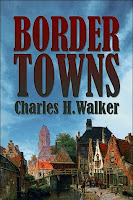 I'm about to post the next chapter of BORDERTOWNS, but before I do, I'd like to share a review of the book by James McClelland.
I'm about to post the next chapter of BORDERTOWNS, but before I do, I'd like to share a review of the book by James McClelland.James, a retired school teacher who is passionate about local history, lives in Emerson, Manitoba. Over the years his knowledge of local history has resulted in several articles, historical essays, and TV documentaries that reflect the pioneering spirit of the Red River Valley...
Border Towns
Charles H. Walker
PublishAmerica 2009
Border Towns was the last novel written by local author Charles (Chuck) Walker. A life time resident of Pembina, North Dakota, Chuck held a deep passion for and knowledge of the local history of the area. This extended to both Canada and the United States. Border Towns reveal both that passion and that knowledge. Chuck passed away soon after Border Towns was released in 2009.Seldom are actual small towns used as settings for novels. Settings are usually fictionalized. They combine the various elements of real life but are constructed to meet the author’s requirements for authenticity. It is therefore somewhat unique that Charles Walker’s Border Towns, is set in three historically accurate existing small towns. Set during the late 1870’s Walker presents a realistic and historically accurate depiction of life along the Canada / United States border when settlers were moving into the area. Emerson, Manitoba, St. Vincent, Minnesota and Pembina, Dakota Territory, are the setting for story that is played out on backdrop of the building of the railway between Winnipeg, Manitoba and Minneapolis, Minnesota. Border Towns is also the account of the McLaren family who saw little future in farming in Eastern Canada and arrive at the border in 1878 to take advantage of the better opportunities offered in the west. They arrive at the same time as large numbers of railway construction workers, “opportunists, and ne’er-do-wells”. The frontier towns are booming and the McLarens soon are challenged not only by their new physical surroundings but also by some of the individuals they encounter. Although opportunities abound the life is raw and fraught with danger and violence.
While Walker presents the grittiness of these times he also reveals the expectations and zeal of the people and the beauty and power of the prairie landscape. His dialogue is rich with the style of the times, including words no longer in common parlance.
They slept on the floor of Germaine’s cabin and woke in the morning to find a strong northwest wind with new-falling snow.Similarly, great care was taken in his accurate description of the local scene.
The mush Germaine fried for their breakfast was scorched, adding to the foul odor of the cabin. A near whiteout storm was whipping up, forcing the men to hurriedly pack up their furs and saddle-up. While saddling the horses and putting the packs on the mule, Ian glanced out of the open-sided lean-to at the blowing snow.
"It’s going to be a humdinger, Pete."
The main street, of Pembina seemed bleak when they reached the west riverbank. Two teams with bobsleighs were parked just ahead, on the right, and two saddle horses stood at the rack in front of the Brown and Kabernagle Saloon.Because of Walker’s profound knowledge of the local history many historical events abound. The arrival of the first train at the border is an example.
Kirby joked, “Cripes, you could shoot a cannon down Cavalier Street and hardly hit a thing.”
The entire countryside was anxious to be at the Emerson depot to greet the first train from St.Paul.Local readers will recognize other historical characters and places that are woven into the fabric of the novel. Readers anxious for realistic details of local history will find themselves searching for the particulars of localities and events that Walker describes.
“Ian got off work at six this morning…He’ll join us in Emerson…it’s a pity we all can’t go to Roseau Crossing to see the spike driving ceremony…”
It was nearly noon before the two buggies crossed the International boundary and proceeded north along Emerson’s Main Street…on Church Street, they noticed each hitch rail…was occupied by riding horses or teams. The saloons were evidently doing a good business, due to the crowds…The stop in Emerson was brief; with a sudden surge of power the high driving wheels of engine slipped momentarily, then slowed to seize the rails…as the train moved north to the ceremony planned at Roseau.
Border Towns is an easy read and as one moves toward the climax it becomes a fascinating page turner. Border Towns is available from the publisher or online from Barnes and Noble.
Thank you for publishing the book on here, Trish! When I was up in Hallock for Dad's funeral, several people came to me and told me that they read it.
ReplyDeleteYou're quite welcome, Mike...and thanks so much for sharing that, it's always so nice to know that people actually read my posts. I love my hometown area and its history and love 'getting the word out'!!
ReplyDelete